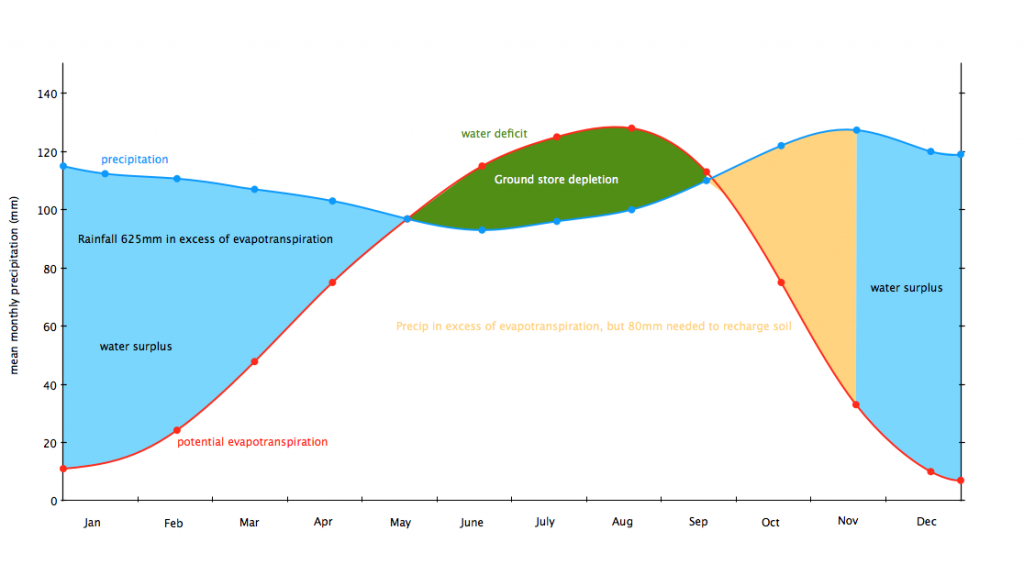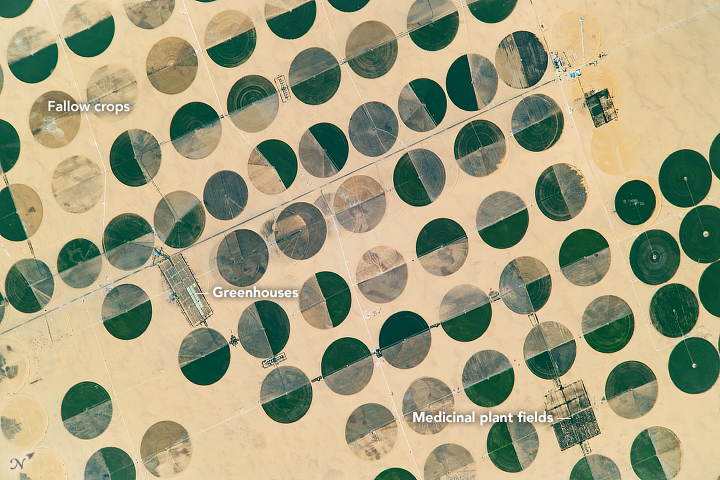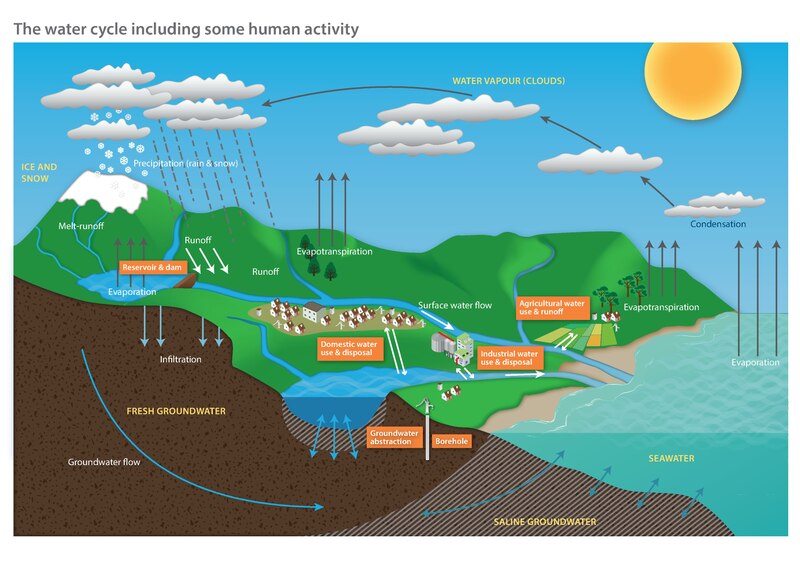AQA Specification focus:
‘Changes in the water cycle over time: natural variation (storm events, seasonal changes), human impacts (farming, land use change, water abstraction).’
The water cycle undergoes temporal changes due to both natural variability and human activity, altering its stores, fluxes, and resulting water availability across spatial and temporal scales.
Natural Variation in the Water Cycle
Storm Events
Storm events are intense weather occurrences, typically involving heavy rainfall over a short duration. These events influence the magnitude of water flows in drainage basins and can lead to temporary but significant changes in the hydrological cycle.
Increased precipitation leads to higher infiltration rates until saturation is reached.
Once saturated, surface runoff increases rapidly, leading to higher discharge in rivers.
Flooding becomes more likely, especially in urbanised or impermeable landscapes.
Evapotranspiration may decrease during the storm but may rise post-event due to increased surface water availability.
Surface runoff: The flow of water occurring when excess stormwater, meltwater, or other sources flow over the Earth's surface.
Storms can also affect the interception capacity of vegetation. For example, during intense rainfall, vegetation may become saturated quickly, reducing its ability to intercept and temporarily store water.
Seasonal Changes
Seasonal variation plays a significant role in determining the rates of water movement and storage across various components of the water cycle.
Winter months (in temperate climates):
Lower rates of evaporation and transpiration due to reduced solar radiation and lower temperatures.
Water may be stored as snow or ice, especially in upland areas, contributing to cryospheric storage.
Soil moisture levels are higher due to decreased evaporation and transpiration.
Spring/summer months:
Increased solar radiation leads to higher evapotranspiration.
Snowmelt contributes significantly to river discharge in regions with seasonal snowpacks.
Soils can become drier, increasing infiltration capacity, but also increasing water stress in drought-prone regions.
These patterns create annual fluctuations in river regimes (the seasonal pattern of river discharge), which impact agriculture, water management, and flood risk.

This chart shows mean monthly precipitation (blue), potential evapotranspiration (red), and the shaded areas of water surplus (blue fill) versus deficit (green fill) in a typical drainage basin. It highlights how wet seasons produce surplus water stored in soils and dry seasons deplete groundwater stores. Source
Human Impacts on the Water Cycle
Farming Practices
Agricultural activity directly modifies water movement, particularly through the manipulation of soil, vegetation, and drainage.
Irrigation introduces additional water to the system, altering the natural balance and increasing evapotranspiration.
Ploughing changes the structure of the soil, often enhancing infiltration but also increasing the risk of erosion and runoff in heavy rain.
Pastoral farming can lead to soil compaction from livestock, reducing infiltration rates and increasing surface runoff.
Use of agrochemicals can pollute surface and groundwater stores, impacting the quality of water, though this is more a water quality issue than a quantitative hydrological change.
Evapotranspiration: The combined process of water loss from the Earth's surface by evaporation and from vegetation by transpiration.

A NASA Earth Observatory image showing circular crop fields created by centre-pivot irrigation in Egypt’s Sharq El Owainat. It demonstrates large-scale groundwater pumping and irrigation infrastructure in a desert environment, illustrating human alteration of the water cycle. Source
Land Use Change
Alterations in land cover—particularly due to urbanisation and deforestation—have significant effects on the flow and storage of water.
Urban development increases impermeable surfaces (e.g., concrete), reducing infiltration and soil moisture storage, while increasing surface runoff.
This leads to flashier hydrographs, where rivers respond more quickly and intensely to rainfall, raising flood risk.
Deforestation reduces interception, transpiration, and soil stability:
Leads to higher runoff and soil erosion.
Decreases root uptake and transpiration, leading to greater soil saturation and possible waterlogging.
Afforestation can have the opposite effect, gradually increasing interception and stabilising runoff patterns.
Water Abstraction
Water abstraction refers to the removal of water from natural stores (rivers, aquifers, lakes) for human use, particularly for domestic, industrial, and agricultural purposes.
Over-abstraction from aquifers can lead to:
Falling water tables, reducing groundwater flow to rivers and wetlands.
Land subsidence in extreme cases (notably in major cities like Mexico City).
Drying up of wetlands, reducing biodiversity and ecosystem function.
Water table: The level below which the ground is saturated with water.
In rivers, abstraction for irrigation during dry periods can lower river discharge, concentrating pollutants and disrupting aquatic ecosystems. This also reduces baseflow, the portion of river flow sustained between rainfall events.

A clear schematic of the water cycle that overlays agricultural irrigation, dammed reservoirs, groundwater pumping, and urban runoff onto the natural stores and flows. Extra elements such as wastewater return flows and engineered drainage are included beyond the syllabus focus. Source
Combined Effects Over Time
Changes to the water cycle rarely occur in isolation. Often, natural variations and human impacts interact, producing complex spatial and temporal patterns in water availability and movement. Examples include:
Climate change intensifying storm events, which when combined with urban expansion, significantly increases flood risk.
Seasonal droughts exacerbated by increased agricultural water use, leading to depleted aquifers and reduced resilience to future shortages.
Land cover change (e.g., deforestation in tropical rainforests) reducing evapotranspiration, which can reduce local precipitation via feedback mechanisms.
These dynamics underscore the importance of understanding how temporal change in water cycle processes shapes not only environmental systems but also human vulnerability and water management strategies.
FAQ
Short-term changes, such as storm events or seasonal shifts, occur over days to months and typically involve temporary fluctuations in water flow or storage.
Long-term changes result from sustained processes like climate change, deforestation, or persistent water abstraction. These can permanently alter the water balance, river regimes, or groundwater availability.
Understanding both is important to assess hydrological resilience and vulnerability.
Different soil types affect how water infiltrates or runs off:
Sandy soils allow rapid infiltration, reducing surface runoff.
Clay soils retain water, increasing the chance of surface runoff and flooding.
Compacted soils from farming or construction reduce infiltration, increasing overland flow.
Thus, the same land use change may impact water flow differently depending on local soil characteristics.
Yes. Climate change causes long-term shifts in rainfall patterns and evaporation rates, which directly alter the water cycle over time.
Key effects include:
More intense storm events increasing runoff and flood risk
Longer dry periods reducing water availability
Melting cryospheric stores altering seasonal river flows
Though broader in scope, climate change contributes to both natural and human-induced changes in the cycle.
Vegetation influences the cycle through:
Interception: Leaves and branches slow rainfall, reducing direct runoff
Transpiration: Water is drawn from the soil and returned to the atmosphere
Root structure: Enhances infiltration and reduces erosion
Removing vegetation disrupts these processes, increasing runoff and lowering evapotranspiration, especially in deforested areas.
Excessive water abstraction can deplete aquifers faster than they can naturally recharge.
Consequences include:
Lowered water tables
Drying of springs and wetlands
Land subsidence in extreme cases
Sustainable abstraction requires monitoring recharge rates and limiting extraction to avoid long-term damage to water stores.
Practice Questions
Identify three human activities that can lead to changes in the magnitude of water stores within a drainage basin. (3 marks)
Mark Scheme for Question 1:
1 mark for each correct human activity (maximum 3 marks).
Accept any of the following:
Irrigation
Deforestation
Urbanisation
Water abstraction
Farming (general or specific practices such as ploughing or livestock grazing)
Construction of reservoirs/dams
Explain how seasonal changes can influence the processes and flows within the water cycle. (6 marks)
Mark Scheme for Question 2:
Award up to 6 marks for a developed explanation.
Indicative content:
In winter, lower temperatures reduce rates of evaporation and transpiration (1 mark).
Water may be stored as snow and ice, reducing surface runoff and increasing cryospheric storage (1 mark).
In spring and summer, increased solar radiation leads to higher evapotranspiration (1 mark).
Snowmelt in spring increases river discharge and surface runoff (1 mark).
Drier summer soils increase infiltration capacity but may reduce water availability (1 mark).
Seasonal variation affects water balance and can influence flood or drought risk (1 mark).
Allow development marks where explanations are linked (e.g., impact of snowmelt on river flow).
Maximum 6 marks.

